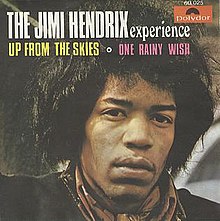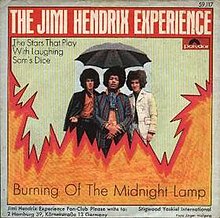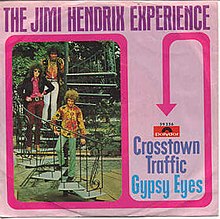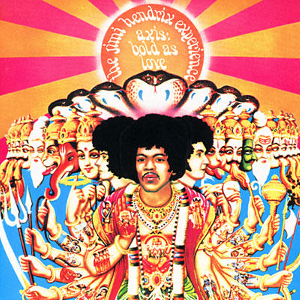Rock and roll music

From Wikipedia, the free encyclopedia
Leer más
Singles chronology
Up from the Skies
Jimi Hendrix
Discográfica: Reprise · Estudio de grabación: Olympic, London · Productor: Chas Chandler
CHARTS
US
|
1
|
Up from the Skies
Jimi Hendrix •
w: Jimi Hendrix •
1968 /02 /26
|
2:57 |
|
|
|
2
|
One Rainy Wish
Jimi Hendrix •
w: Jimi Hendrix •
1968 /02 /26
|
3:42 |
|
Album
Axis Bold As Love
Fecha Lanzamiento: 1 Diciembre 1967 · Fecha Grabación: Diciembre 1967 -Discográfica: Polydor/Track (UK) Reprise (US) Barclay (France) · Estudio de Grabación: Olympic, London · Productor: Chas Chandler
|
1
|
Exp
Jimi Hendrix •
w: Jimi Hendrix •
1967 /05 /12
|
1:55 |
|
|
|
2
|
Up From The Skies
Jimi Hendrix •
w: Jimi Hendrix •
1967 /12 /01
|
2:57 |
|
|
|
3
|
Spanish Castle Magic
Jimi Hendrix •
w: Jimi Hendrix •
1967 /12 /01
|
3:05 |
|
|
|
4
|
Wait Until Tomorrow
Jimi Hendrix •
w: Jimi Hendrix •
1967 /12 /01
|
3:01 |
|
|
|
5
|
Ain't No Telling
Jimi Hendrix •
w: Jimi Hendrix •
1967 /12 /01
|
1:49 |
|
|
|
6
|
Little Wing
Jimi Hendrix •
w: Jimi Hendrix •
1967 /12 /01
|
2:27 |
|
|
|
7
|
If 6 Was 9
Jimi Hendrix •
1967 /12 /01
|
5:33 |
|
|
|
8
|
You Got Me Floatin'
Jimi Hendrix •
1967 /12 /01
|
2:47 |
|
|
|
9
|
Castles Made Of Sand
Jimi Hendrix •
w: Jimi Hendrix •
1967 /12 /01
|
2:47 |
|
|
|
10
|
She's So Fine
Jimi Hendrix •
w: Noel Redding •
1967 /12 /01
|
2:39 |
|
|
|
11
|
One Rainy Wish
Jimi Hendrix •
w: Jimi Hendrix •
1967 /12 /01
|
3:42 |
|
|
|
12
|
Little Miss Lover
Jimi Hendrix •
w: Jimi Hendrix •
1967 /12 /01
|
2:23 |
|
|
|
13
|
Bold As Love
Jimi Hendrix •
w: Jimi Hendrix •
1967 /12 /01
|
4:12 |
|
Album
| "Up from the Skies" | ||||
|---|---|---|---|---|
 Spanish single picture sleeve | ||||
| Single by the Jimi Hendrix Experience | ||||
| from the album Axis: Bold as Love | ||||
| B-side | "One Rainy Wish" | |||
| Released | February 26, 1968 | |||
| Recorded | October 29, 1967 | |||
| Studio | Olympic, London | |||
| Genre | Psychedelic rock, jazz fusion[1] | |||
| Length | 2:55[2] | |||
| Label | Reprise | |||
| Songwriter(s) | Jimi Hendrix | |||
| Producer(s) | Chas Chandler | |||
| Experience US singles chronology | ||||
| ||||
Review
From Wikipedia, the free encyclopedia
Leer más
1968 single by the Jimi Hendrix Experience
"Up from the Skies" is a song written by Jimi Hendrix. Recorded by the Jimi Hendrix Experience in 1967, it was released on their second album Axis: Bold as Love. The lyrics reflect Hendrix`s interest in science fiction and relate an extraterrestrial visitor`s curiosity about life on Earth. Musically, it incorporates elements of jazz, particularly in drummer Mitch Mitchell`s use of brushes.
In 1968, the Experience`s American record company, Reprise Records, released the song as a single, which reached number 82 on the Billboard Hot 100 chart.[3]
Background and style
"Up From the Skies" was recorded on October 29, 1967, the last day of recording for Axis: Bold as Love, at Olympic Sound Studios in London.[3] AllMusic reviewer Matthew Greenwald described the song as "a breezy, jazz-based stroll, and it`s quite different from anything on his debut album".[4] Biographer Harry Shapiro commented on the "easy triplet jazz feel", bringing attention to the "delicate wah-wah and Mitch [Mitchell]`s brush-work".[3]
The lyrics are told from perspective of a visiting alien "concerned about what has happened to [Earth] since the last time he passed through".[3] Greenwald suggests that this motif is adopted to "[address] the older generation and their flaws and judgements against the youth of the 1960s", which Hendrix supposedly does "with a sense of idle curiosity rather than distaste, not unlike an alien visiting the planet Earth for the first time".[4]
Reception
Despite being less commercially successful than previous singles, "Up from the Skies" was generally well-received critically. In an album review for Rolling Stone, critic Parke Puterbaugh identified the song as an effective opening song for the album, suggesting that "`Up From the Skies`, the mission statement of Axis: Bold As Love, [draws] the ear into an album that wanted to take you higher, past gravity or limits of any kind".[5] Music writer Cub Koda summarized the song as a "spacy rocker".[6] Cash Box said that Hendrix is in a "funkier groove" here than some of his previous singles, saying the song is "almost a step back into blues of the mid-fifties but with some contemporary guitar antics that are straight from the today trends."[7]
From Wikipedia, the free encyclopedia
1968 single by the Jimi Hendrix Experience
"Up from the Skies" is a song written by Jimi Hendrix. Recorded by the Jimi Hendrix Experience in 1967, it was released on their second album Axis: Bold as Love. The lyrics reflect Hendrix`s interest in science fiction and relate an extraterrestrial visitor`s curiosity about life on Earth. Musically, it incorporates elements of jazz, particularly in drummer Mitch Mitchell`s use of brushes.
In 1968, the Experience`s American record company, Reprise Records, released the song as a single, which reached number 82 on the Billboard Hot 100 chart.[3]
Background and style
"Up From the Skies" was recorded on October 29, 1967, the last day of recording for Axis: Bold as Love, at Olympic Sound Studios in London.[3] AllMusic reviewer Matthew Greenwald described the song as "a breezy, jazz-based stroll, and it`s quite different from anything on his debut album".[4] Biographer Harry Shapiro commented on the "easy triplet jazz feel", bringing attention to the "delicate wah-wah and Mitch [Mitchell]`s brush-work".[3]
The lyrics are told from perspective of a visiting alien "concerned about what has happened to [Earth] since the last time he passed through".[3] Greenwald suggests that this motif is adopted to "[address] the older generation and their flaws and judgements against the youth of the 1960s", which Hendrix supposedly does "with a sense of idle curiosity rather than distaste, not unlike an alien visiting the planet Earth for the first time".[4]
Reception
Despite being less commercially successful than previous singles, "Up from the Skies" was generally well-received critically. In an album review for Rolling Stone, critic Parke Puterbaugh identified the song as an effective opening song for the album, suggesting that "`Up From the Skies`, the mission statement of Axis: Bold As Love, [draws] the ear into an album that wanted to take you higher, past gravity or limits of any kind".[5] Music writer Cub Koda summarized the song as a "spacy rocker".[6] Cash Box said that Hendrix is in a "funkier groove" here than some of his previous singles, saying the song is "almost a step back into blues of the mid-fifties but with some contemporary guitar antics that are straight from the today trends."[7]






